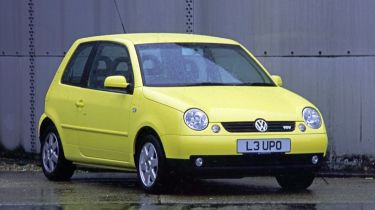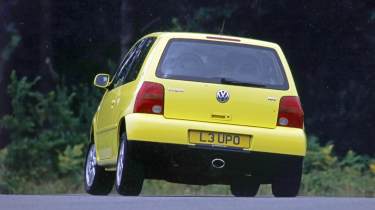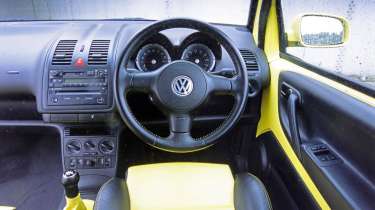Used Volkswagen Lupo (Mk1, 1999-2005) buyer’s guide: rare city car will turn heads
A full used buyer's guide on the Volkswagen Lupo that was on sale between 1999 and 2005
Verdict
With the newest Volksweagen Lupos now two decades old, really nice examples are becoming ever-harder to find. But we can assure you that it’s worth searching for one if you fancy something that’s easy to park, costs buttons to run and is easy to maintain. Of course these cars have the minimum of tech; even when compared with the latest city cars, the Lupo is very basic. For many, that’s a good thing, because there’s less to go wrong, there’s no interference with the driving and it keeps the cost of maintenance down. Perhaps unsurprisingly, practicality isn’t a strong suit, but as a cheap runabout that will probably be a second car, the Lupo makes a great buy.
Until the arrival of the Lupo in 1999, Volkswagen had never offered a city car. The original Beetle arguably sat in the bigger supermini segment, although in period it would have been seen as a small family car. Either way, when the Lupo arrived it, broke new ground for Volkswagen.
With its high-quality cabin, excellent road manners and smart design, the Lupo was definitely a premium option when new, and for years used values reflected its position in the marketplace.
Used - available now

2021 Honda
Civic
68,357 milesManualPetrol1.5L
Cash £11,697
2023 Kia
Sportage
19,611 milesManualPetrol1.6L
Cash £18,600
2020 Ford
Focus
28,300 milesManualPetrol1.0L
Cash £11,600
2023 Mercedes
A-Class Saloon
64,383 milesAutomaticPetrol1.3L
Cash £16,200But now the Lupo is a modern classic and while these smart-looking tiddlers are less readily available than they used to be, they’re worth seeking out because they offer so much in return for so little. The Lupo is proof indeed that sometimes the best things do come in small packages.
History
The Lupo was launched in February 1999 with a choice of 50bhp 1.0 or 1.4-litre petrol engines plus a 60bhp 1.7 SDi naturally aspirated diesel. The 1.4-litre engine put out 75bhp in the Lupo E and S, but 100bhp in the Sport, which was added to the range just three months later.
From July 2000 there was a 75bhp 1.4 TDi turbodiesel option. By the end of 2000 the Lupo that everyone now wants was on sale: the 125bhp 1.6-litre Lupo GTi, which initially came with a five-speed manual gearbox; from May 2001 a six-speeder was standard fare.
From May 2003 all Lupo engines were Euro 4 compliant and from April 2004 all models came with anti-lock brakes.
Prices
There aren’t loads of Lupos for sale, and most of the ones that are available are being sold privately, because their low values mean there isn’t enough margin in them for traders to sell them. Values are generally set according to mileage, spec and condition, rather than age, although newer Lupos tend to fetch more than early cars.
Unfortunately we don't have any used VW Lupos for sale via our Buy a Car service, however we do have an extensive range of other used Volkswagens. Click here now to get a great price.
Check the price of a Volkswagen Lupo with our free car valuation tool...
On the road
Most Lupos weigh less than a tonne; even the 1.4 TDI is just 1,057kg, and that shows in the driving experience. The Lupo feels agile and fun with well weighted steering (power assistance was standard range-wide from January 2000), but the suspension is tuned for comfort rather than sharp handling; the ride is impressive for such a short and lightweight car.
Entry-level Lupos with the 1.0-litre engine feel underpowered, so we’d aim for at least a 1.4-litre powerplant. The 1.0-litre cars also did without a front anti-roll bar, so they don’t corner as sharply as more powerful editions.
Which one should I buy?
The obvious answer is the GTi, because these are the most fun and the most collectible; just six per cent of Lupos sold were GTi editions; the 1.0E was the biggest seller. But you pay a big premium for a GTi, and if you want cheap transport you’re better off going for a 1.4-litre car; the SDi is a bit gutless but the TDi is much perkier. All diesels are frugal though.
No Lupo is lavishly equipped, with the entry-level E especially basic. Standard kit ran to a four-speaker radio/cassette along with front airbags for the driver and passenger, and that was it.
The Lupo S added central locking, electric windows and height adjustment for both front seats. Sport trim brought anti-lock brakes, electrically adjustable door mirrors, heated windscreen washer jets and 14-inch alloy wheels.
The GTi was also fitted with an alarm, xenon headlights, an eight-speaker hi-fi, sport seats and 15-inch wheels. While the E and S came with a full-size steel spare wheel, the Sport had a space saver and the GTi a tyre-repair kit.
Alternatives to the Volkswagen Lupo
The SEAT Arosa is the same car with different badges. The Arosa is even more unusual now than the Lupo and there was no GTi option, but prices for these tiny SEATs are temptingly low, with running costs just as palatable.
The Lupo was up against the Ford Ka, and these make a great cheap buy in first and second-generation forms, although the former can rot particularly badly.
The Citroen Saxo and Peugeot 106 are essentially the same car and are both cheap runabouts; you could also consider the Citroen C1 and C2 along with the Peugeot 107. The Toyota Yaris is another high-quality alternative that’s much more roomy in the back.
What to look for
Unsafe mods
The Lupo has been really popular with young drivers for a long time, and many of them have modified their cars. Make sure any changes to the suspension, exhaust, lights, ECU, etc have been done well.
Bodywork
The roof gutters can rust, and so can the sills and rear wheelarches. The GTi’s spoiler can absorb water, leading to paint problems, while the door-check strap can fail and the doors drop from weak hinges.
Electrics
An array of electrical maladies is common, including failed xenon headlights on the GTi, rear wiper failure and the central locking not functioning. The windows stop working when the switches fail.
Other issues
Early pedal boxes were weak and their welds could fail; later cars had a redesigned set-up. Gearboxes are weak as the bearings wear; the transmission can fail with no warning.
Interior
Bijou and simple sum up the Lupo’s cabin. The dashboard is basic but clearly laid out and the build quality is great, but air-conditioning was optional. Front-seat comfort is good but the back seats are cramped and two seatbelts is the norm; Isofix mountings were standard from June 1999. Boot space is 140 litres, or 830 litres with the seats down.
Running costs
Unless you buy a liability that needs lots of new parts, the running costs of any Lupo should be very low.
While the GTi sits in a surprisingly high insurance group 22, all other models are in groups 5-12; most
are in group 7. For Lupos registered before 1 March 2001, all cost £220 per year to tax, apart from the SDi and GTi, which are £360. For cars registered later, annual VED varies vary between £195 (1.0) and £345 (GTi), although the diesels are £35. The fuel economy varies from 38-64mpg depending on the engine.
Maintenance should also be cheap. The interval is set at every 12 months or 10,000 miles, while all engines need a fresh cambelt every four years or 40,000 miles. Any decent garage can maintain a Lupo, typically for £200-£300 per year, with cambelt replacement around £400.
Recalls
VW has issued only two recalls for the Lupo, most recently 20 years ago, so any example that’s still in use should have had any necessary repairs made by now.
The first recall was issued in July 2002, and it affected more than 120,000 Lupos and Polos made between May 1997 and December 1999. On the production line these were fitted with sub-standard vacuum pipes for the brake servo. The pipes could fail leading to a loss of servo assistance, although there was no chance of brake failure; new pipes were the solution.
The second recall came in March 2005, because almost 50,000 diesel-engined VWs (including some Lupos) made between March and August 2004 left the factory with faulty fuel pumps that could leak.
Driver Power owner satisfaction
Although the Ford Ka and Toyota Yaris appeared in our Driver Power surveys, the Lupo didn’t, because not enough owners took part to give a representative sample.
Not that it makes much difference anyway, because anyone looking to buy a Lupo nowadays will be fully aware of its limitations, such as a lack of tech and cabin space, as well as its key strengths. Those include being cheap to buy and run, along with fun to drive.
Did you know you can sell your car through Auto Express? We’ll help you get a great price and find a great deal on a new car, too.






